
You have an unusual background... I guess I’m different to many people in the analytical space because I got here via an engineering path. My father was a bank manager and a real “people person”. His job meant that I grew up in various parts of the north of England before heading down to Brunel University in London to do a degree in manufacturing engineering. Engineering was a good fit for me; I focused on mathematics, physics and chemistry at school. In essence, I recognized that I liked building stuff and solving problems. The great thing about Brunel was the mix of work and studying, which is how I ended up on several placements at Ford. An emphasis at Ford back then was on low-weight engine materials and reduced environmental impact – so I got to work on some fun and thought-provoking projects. It was particularly interesting to see how much science was being applied to engineering problems – there was a lot of innovation. And I was surprised by the pace and ambition.
And you stayed with Ford? That’s right. I stayed on at Ford working on engineering problems in several business units for seven years. I also headed up several production facilities and quickly found that I had an aptitude for working with people – even though I was thrown in at the deep end as a graduate manager. I had every trick in the book thrown at me. But honesty and understanding helped me earn respect. I learnt early on that it’s not just about being a boss – it’s about understanding the goals of teams and individual employees, and learning how to align those goals with business objectives. Now, I very much believe that you must find the right people first and then put your plan together around them. Certainly, you need a vision – that’s what gets people on board, but the A to Z route of how you get there needs to flex with the talent of the people around you.
So, what exactly is the route from Ford to Ocean Optics?! After Ford, I joined an electronics firm who were working at the cutting edge of printed circuit board technology. There was a lot of chemistry involved, but it was also my introduction to optics. I was put in charge of imaging processes. After a while, I decided I wanted to work for a smaller organization; I joined the board of a great company called Keeler, which makes ophthalmic instruments. Keeler exists within the same UK-based umbrella group – Halma – as Ocean Optics, along with about 45 other companies. What did you bring to Keeler? We were trying to refresh products and inject some innovation. Innovation is hard – but I could apply lessons learnt from previous experiences. You have to listen, to be open to ideas from inside – and outside – the company, and you have to fully understand the roadblocks and priorities. One project stands out for me – it seems obvious now, and at the time it was groundbreaking – like all the best innovations! A key product at Keeler was a head-mounted indirect ophthalmoscope that depended upon a very bright light. Bright lights required a lot of energy back then, so the device was connected to an electrical outlet. We went in search of a suitable power pack and ended up with a totally integrated solution. There was a big concern about the weight of the battery, but actually it balanced out the optics on the front, something we realized on the first prototype. Innovation can also be about usability or extending applications.
Ocean Optics is a fast-growing company – an exciting next step? Absolutely. I joined in 2006, running operations, and it was incredible to see the scope of applications that Ocean Optics were involved in – and we’ve expanded significantly since then. The diversity now is simply astonishing. And importantly for me, in many cases we’re helping other companies improve life. You’re now president – how are you shaping the company? Much of it is about vision – crystalizing our company mission. And it’s about sharing passion for innovation. I also recognized the true value of the business, which is in applications rather than products. Research (and working with other researchers) is tremendously important to us. We want people to think about Ocean Optics first and we want them to know that they’ll be working with a team that will be completely focused on solving their problem. I hear that from customers now – and more than anything else, I want us to stay in that place as we grow. Needless to say, we have some very exciting research collaborations.
Spectroscopy applications are soaring right now – where is the field heading? The next wave of spectroscopy is likely to enter a space that is much closer to the consumer market. We all have phones in our pockets that have cameras and processing power – and there are some missing pieces that could transform them into very meaningful devices. I foresee a lot of medical/health and food monitoring – all outside of the lab of course. We all want more data and knowledge about how the world around us is affecting our health. Our part in all of this? Well, we’re taking a key-partner approach – all covered by non-disclosure agreements – but you don’t need to research too long before hazarding a guess about who some of those partners might be. There’s a pace and investment behind some of these projects that is refreshing. Within 18–24 months you may see some of that work come to fruition. These are very exciting times.




